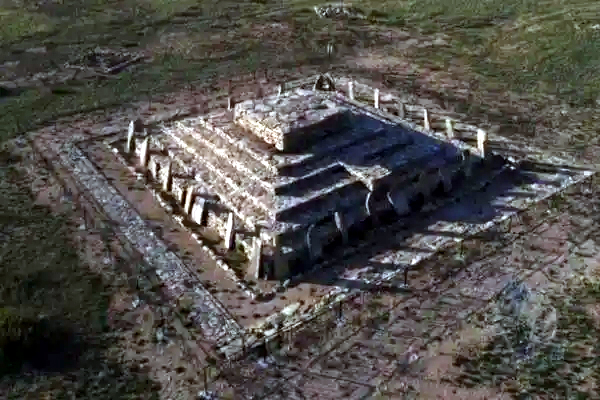
In a groundbreaking archaeological discovery, researchers in Kazakhstan have unearthed a unique 3,800-year-old hexagonal pyramid at the Kyrykungir site near Toktamys village. This remarkable structure, standing approximately 10 feet (3 meters) tall with each side spanning 13 meters (43 feet), is unlike anything previously found in the region. Experts believe the pyramid may have served as a royal tomb or a ceremonial site, representing the spiritual and political significance of the Bronze Age civilization that built it.
A Monument of Precision: The Steppe Pyramid
Unlike the towering pyramids of Egypt, this “Steppe Pyramid” features a flat-topped, hexagonal design, meticulously constructed with massive stone slabs. The arrangement of stones creates a labyrinth-like passage leading to a central burial chamber, suggesting ritualistic significance. The geometric precision of the structure reflects a profound understanding of mathematics, engineering, and possibly astronomy. Researchers speculate that the shape and orientation of the pyramid may have been aligned with celestial movements or seasonal cycles, a characteristic commonly found in ancient burial sites across Eurasia.
Ulan Umitkaliyev, the lead archaeologist from L. N. Gumilyov Eurasian National University, highlighted the complexity and craftsmanship of the site. “The steppe pyramid is constructed with remarkable precision; it is hexagonal, with eight rows of stones forming each face,” he explained. Such architectural sophistication demonstrates the capabilities of a highly organized society with advanced knowledge of construction and spatial planning.
The Andronovo Civilization and Its Cultural Legacy
Archaeologists have linked the hexagonal pyramid to the Andronovo culture, a Bronze Age civilization that flourished across Central Asia between 2000 and 900 BCE. The Andronovo people are renowned for their domestication of horses, which played a vital role in their economy, transportation, and burial traditions.
Excavations within the burial chamber uncovered horse remains alongside finely crafted ceramics, gold earrings, and bronze tools. These findings imply that the individual buried here was of high status—likely a leader, noble, or revered figure. The presence of horse bones is particularly significant, as it indicates the role of equine sacrifices in Andronovo funeral practices. Horses were often interred alongside the deceased, signifying their importance in both life and the afterlife. Similar burial sites across Kazakhstan, Russia, and Mongolia validate this tradition, underscoring the cultural and spiritual significance of horses within Andronovo society.
Ancient Burial Practices and Monumental Construction
The discovery of the Kyrykungir pyramid provides valuable insights into ancient burial traditions in the Eurasian Steppe. Like other Bronze Age sites, the tomb contained ornamental jewelry, weapons, and remnants of feasting rituals, signaling the social status of the deceased. Some researchers theorize that the hexagonal shape of the pyramid may have held symbolic meaning, possibly representing cosmological beliefs or societal hierarchies.
Beyond its spiritual significance, the pyramid also illuminates trade networks and cultural exchanges of the time. The presence of bronze tools and gold ornaments suggests long-distance trade with neighboring regions, indicating that the Andronovo people were not isolated but part of a broader Eurasian network. Their advanced metallurgical skills and ceramic designs further support the notion of cross-cultural interactions that helped shape early civilizations.
The Legacy of the Hexagonal Pyramid
As excavations progress, the Kyrykungir pyramid is poised to redefine our understanding of Bronze Age societies in Central Asia. Historians and archaeologists intend to compare its architectural design with other known monumental structures in the region to determine whether the Andronovo people shared construction techniques with neighboring cultures.
There is also speculation that the site may have been part of a larger ceremonial complex, possibly connected to other burial grounds across the steppe. This would provide new perspectives on how ancient civilizations organized their political, religious, and social structures if confirmed.
For now, the hexagonal pyramid of Kyrykungir stands as a captivating relic of the past, offering glimpses into a civilization that once thrived in the vast Eurasian steppes. With ongoing research, archaeologists hope to uncover more secrets hidden within its ancient stone walls, illuminating the rituals, beliefs, and engineering skills of the Andronovo people—one of the most influential cultures of the Bronze Age.
